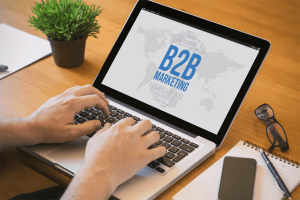Basic elements of a B2B site
To determine the key components of a B2B site, we first highlight the main stages of its creation.
First stage. traffic generation.

There are several options for attracting traffic to a B2B site. If we talk about the long-term effect and the gradual investment of money, then it is important to pay attention to SEO promotion and PR.
Before developing and filling the site, create a semantic core. This is a set of keywords and phrases that are popular in search (Google, Yandex, etc.), by which your service can be found.
The next stage is the development of a structure according to the collected phrase pool and a set of services. Distribution by pages.
Creation of landing pages that present your main services, your company, its features.
An additional, and sometimes the main, source of traffic for a B2B site is the company’s blog. A blog on topics from the chosen field allows not only to expand the number of requests for which customers come to the site, but also to form an image of an expert in a particular field, to help already attracted clients understand complex issues.
PR or mentioning your company on other sites gives you not only advantages in SEO promotion (link mass), but also increases consumer confidence, brand awareness, and expands the circle of visitors.
Second phase. Design, CMS, content
When you have developed a strategy and structure, it is much easier to issue TOR to designers, webmasters, copywriters to launch the site. Although sometimes startups create a low-functional website about the company with its subsequent expansion.
The main thing is to focus on clarity and understandability for the user when developing design and content. Your clients will thank you for taking care of their time and convenience. In addition, search engines will appreciate the structure and usability of the site.
Third stage. Conversion
Perhaps this is one of the most difficult stages. Let’s say you were able to attract 1000 users to the site every month. But how do you turn them into real customers?
For lead generation, you can create:
- registration form (via email, phone number or social networks);
- subscription form for blog or company news (email, push, social networks);
- call-to-action buttons;
- Lead magnet, etc.
What is lead generation?
The idea of moving a user through the sales funnel here is that after the first acquaintance with the company’s services, he gradually moves from interest (subscription) to making a purchase decision. For B2B companies, attracting traffic with the help of the site (content) is combined with the work of the sales department. The site generates leads by redirecting all incoming traffic to landing pages, from there to the registration form, where the visitor leaves his contact. Then marketers continue to work with the lead until it turns into a buyer.
Many B2B companies use CRM systems to collect customer data from different marketing channels.
The lead base is collected when a visitor leaves his contact information in one of the forms of communication on the site (email, phone number, subscription through a social network account).
But sites also use a simpler method of collecting a subscriber base using push notifications. Through this channel, the base is collected many times faster than through other tools. The push subscription window appears automatically when visiting the site, and the user only needs to make one click to subscribe or reject the offer. If the visitor has allowed him to send push notifications, he enters the subscriber database. Now you can continue to communicate with him when he leaves the site.
Connect push notifications to the site
Of course, for good results, it is important to use different marketing channels, taking into account the characteristics of the target audience and its needs. For example, it is more convenient for someone to conduct business email correspondence, for someone to receive a promotional offer in a messenger, and for someone to see the news about updating the service package in a push notification.
So, the main elements of a B2B site:
- CMS – a task for a webmaster;
- Design – here you need a web designer;
- Text and media content – work for copywriters;
- Website optimization for search engines – SEO specialist skills;
- A set of marketing channels for promotion is the work of marketers;
- Tools to increase conversions are the responsibility of marketers and sales departments.
Why is having a website important for B2B companies?

Why is it important to create a website for B2B sales? What does it bring to business?
- Visibility of the company, product.
- Expanding the audience of potential buyers.
- Resources to attract users and engage them in a dialogue with the company.
- Availability of information about the service 24 hours a day.
- Opportunities to increase conversions.
- Online sales.
A platform for forming opinions, generating ideas.
To successfully promote your product, a business has to create a truly effective platform for interacting with customers.
If you have questions about the operation of marketing channels for mailing lists, please contact our support department.
